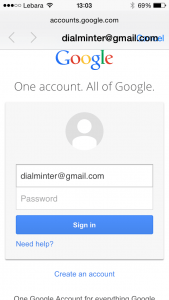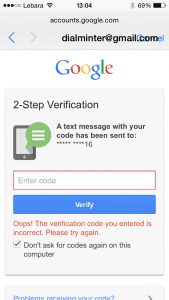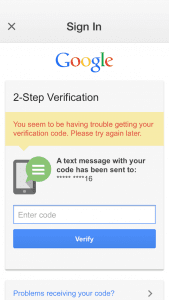How important is your privacy? Typically, it’s supremely important, right? And, if you were asked about the importance of your security, you would inevitably also put a high value on your protection, right?
2-step verification
If you are like me (and the majority of us, I’d say), keeping your information safe is a major concern. For example, you would be mortified if your accounts were hacked. It is for this that we are advised to have long, complicated and different passwords across all our digital devices, platforms and services. It because of this concern for security that companies like Google and Facebook provide bulked up methods, including 2-step verification, aka two factor authentication (via code generator, sms, email confirmation, etc). On balance, if you are not already doing so, you ought to be using 2-step verification.
However,…
Sometimes, there can be a bug. First, you don’t want to forget your password. Secondly, you will need to have easy and immediate access to the required second step. When you are traveling this can become particularly troublesome – for example, if you have multiple phones or are avoiding roaming charges, etc. Moreover, you can also become a victim to incompatible devices or services. I had such a case recently with my gmail.
User experience woes

Using iOS mail to aggregate my mails on my mobile (iPhone), I was informed that my password needed updating. This could be part of a regular security check, I reasoned. So, I re-entered my details on the screen that popped up on top of my mail (see right). On my little iOS keyboard, I dutifully entered my email address and entered my complex and unique password (replete with upper and lower case, letters and symbols…). Once that was completed, I was invited to enter my 2-step verification code (an sms to the phone in my palm). In order to access the sms (which I didn’t allow to appear in my notification center or as a banner), I had to click out of the page and go to Messages. Once I had collected my code, I went back to the mail app. The pop up screen had disappeared. I had to start all over again. And, that meant having to type in my email and password from scratch… again.
Unfortunately, I got the same pop up and needed to resend a 2 step verification code. Had I known the number was going to be exactly the same, I might have tried it the second time. However, I went through the same process and, rather frustratingly, ended up in the same predicament. Except, on the third attempt, I was given the following message (below).
Oops! The verification code you entered is incorrect. Please try again.

I note that ticking the “Don’t ask for codes again on this computer” never seems to work.
On my fourth and last attempt, I ended up getting the following message:
You seem to be having trouble getting your verification code. Please try again later.

This was code for: we don’t trust you as being the rightful owner of the account.
Customer service experience…
When I went home to use another device to access and clear the whole situation up…later, I was asked a battery of questions by Google that included which date I opened up my gmail account, names of up to four labels, the recovery email address. I don’t know about you, but that seems ridiculously vague in my memory and I didn’t ever write that data down. Other questions seemed deliberately obscure or unclear and left me scratching, then shaking my head. After a concerted effort, a few calls to my trusty troubleshooting friends and without any recourse to a Google help desk of any sort, I was able to find a way back in. However, the process was quite titanesque and, potentially threatening for my business.
A great mobile user experience is not easy
Why do I bother recounting the whole story? Not specifically to rail against Google for trying to keep my accounts secure. I still very much subscribe to the 2 step verification. It is really to warn brands — especially the big ones — to make sure that they look deeply at the user experience when implementing their mobile applications and solutions. What is the customer journey for your typical or target customer? How can the experience be made seamless? In the case of Google’s gmail, the issue in the middle is the iOS mail — and there are surely many iOS users who have a gmail account. But, somehow, in order to ensure a superior mobile user experience, customer service will need to be on guard, if not enhanced.
The moral of the story?
First, on the side of the consumer, it is to make sure you always have 2nd step easily accessible. Two, make your SMS (if that’s the prefered channel for the second factor of authentication) pop up as a banner so you don’t NEED to exit the existing screen. NB: even if I toggled screens by pushing the home button twice, the first screen in mail would disappear. The other work around would have been to use the Google mail app instead.
That said, the real moral of the story is that the mobile is now the singularly indispensable and aggregated screen. {Tweet this!} As brands, we must all be paying more attention to the mobile user experience — including the user journey — as we upgrade our investments in mobile platforms.











Yup I’m in this situation. Google stopped sending me verification codes and the message says “try again later”. The ridiculous thing is, I have access to BOTH my secondary options — my phone and my separate email account. However, Google sends me an email with a link to my secondary account, which I am able to click on, and this leads to the “try again later” screen. Very sloppy. Google has gotten complacent about the user experience. I don’t know what to do. I guess I can start the multi-day process but will they mess that up too?
How did you find a way to be back in? I’ve sent the request 3 times answering correctly the most important questions and approximately the dates but they seem to think is insufficient.
I have had the same issue. And it is veryfrustrating to say the least. Google needs to figure out a way to fix this if they are going to offer the two step process!